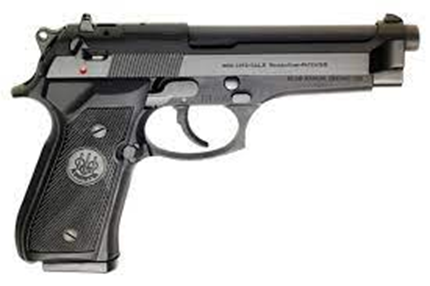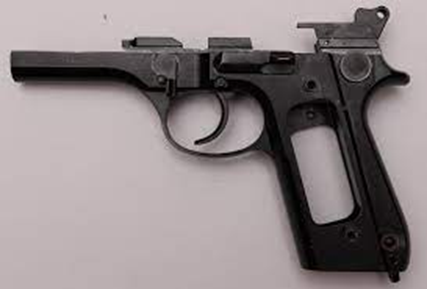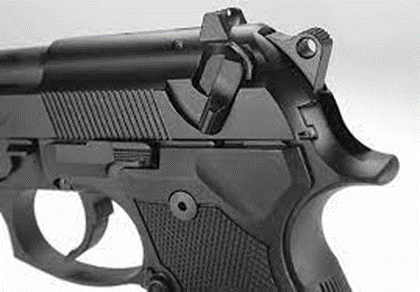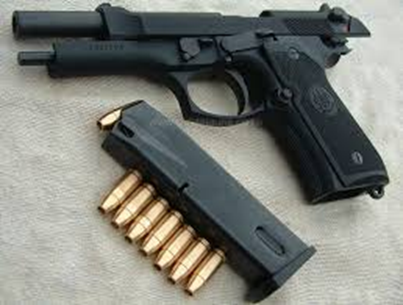The Beretta 92FS is arguably one of the most iconic semi-automatic pistols of all time.
If you are a fan of movies like the Diehard series and Lethal Weapon, you know and recognize the Beretta 92FS. Those who spent time in the U.S. armed forces for any time in the late 1980s and through the 1990s know this pistol as the standard issue M9 sidearm.
The Beretta 92fs is a workhorse of a pistol.
The lineage of the Beretta 92FS goes back to the Beretta M1923 and M9151 designs.
The open slide, the alloy frames, and the locking block barrel all have been seen on earlier Beretta semi-automatic pistols. One notable design is the direct feed magazine that removes the need for a feed ramp between the magazine and the chamber.
The US military replaced the M9/92fs in 2017 with the SIG Sauer M17, a militarized version of the SIG Sauer pP320 semi-automatic pistol. However, the Beretta 92FS remains in use around the world with military and law enforcement agencies.
Many civilian shooters also routinely use their Beretta 92FS pistols for both self-defense and target shooting.
SKIP AHEAD
Overview of the Beretta 92FS
The Beretta 92FS is a full-size, all-metal, semi-automatic pistol generally chambered for the 9x19mm cartridge. Beretta does make the 92fs in different calibers, but the 9mm variant remains the most popular and the most available.
The Beretta 92fs is a pretty straight forward gun for personal defense and with superior reliability.
Over the years, Beretta evolved the 92 line of pistols as improvements and upgrades were made. The eventual result was the 92FS, including the 92FS Centurion, which featured a shorter barrel and slide.
One of the major additions was made in 1978 with the addition of an external safety and decocking lever mounted on the slide. This change satisfied the requirements of many European police forces, which were rapidly adopting the 92FS as their duty hand guns.
Some later variants of the Beretta 92FS used some polymer parts to reduce the overall weight of the pistol. The use of polymer also helped Beretta keep the cost of producing the 92fS under control. Parts such as the recoil spring guide rod, magazine floor plates, magazine follower, and the magazine release button feature polymer or polymer-coated metal parts.
Nothing Looks Like a Beretta 92FS
Perhaps one thing that has made the Beretta 92FS such an iconic piece of design is the look of the gun.
During the heyday of the action-adventure movies in which the Beretta 92fs figured so prominently, this Beretta pistol didn’t look like any other gun. That made the Beretta easy to spot on the screen. It seemed like everyone wanted to get their hands on the gun that Keanu Reaves used so spectacularly in The Matrix.
The exposed barrel and the open-top slide design give the 92fs a distinctive look that continues to set this pistol apart visually from the current line of striker-fired pistols that have flooded the market in recent years. This arrangement is possible because of the falling-block design that keeps the barrel in line instead of rotating and moving like pistols that utilize the Browning design.
Many shooters continue to believe that this straight-line barrel design delivers better accuracy than many striker-fired pistols. In addition, this barrel arrangement makes the use of suppressors on the 92fs possible. If you haven’t shot a 9mm pistol with a good suppressor, you should give it a try. It can take your shooting experience to a new level.
Note: Even light target loads will cycle the action reliably, making this a great gun purchase for many first time gun owners.
Beretta 92FS From an Operational Standpoint
Despite what you may have heard from many people, the Beretta 92FS offers superior reliability in its current versions.
There are many disparaging comments floating around the internet about problems with the operation of the Beretta 92FS. However, 20-plus years of duty-proven handgun designs in use with the U.S. military tell a different story.
I purchased my first Beretta 92FS in the mid-1990s. I got caught up in the whole action-movie genre like many other shooters. I had also heard the stories about the shortcomings of these semi-automatic pistols. Over time, I became convinced that much of the problems associated with these Beretta pistols were due to abuse or lack of maintenance.
I found my Beretta 92FS to be a beast. It went to the range on a regular basis, accompanied me on hunting trips where it was subjected to all kinds of nasty environmental conditions, and I fed it my reloads on a regular basis. I never had a complaint about the functioning of my Beretta 92FS.
Note: Left-handed shooters will appreciate the ambidextrous safety and the reversible magazine release.
The Beretta 92FS In Depth
I like to look at every pistol I review in detail to give readers an understanding of the mechanics, features, and specifications of the gun. I almost always start with the factory specifications as a basic starting point for discussing the firearms that I review.
Beretta 92FD Factory Specifications
- Action – Single/Double Action trigger
- Barrel Length – 4.9 inches
- Caliber – 9×19 (9mm parabellum)
- Magazine capacity – 15 rounds
- Overall Height – 5.4 inches
- Overall Length – 8.5 inches
- Overall Width – 1.5 inches
- Weight Unloaded – 945 grams or 33.3 ounces
- Magazine Capacity – 15 rounds
- Frame Material – Aluminum Alloy
Features
- Open slide design
- Short-recoil locking block system
- Reversible Magazine Release
- Ambidextrous safety lever doubles as a decocker
- Bruniton finish for extraordinary durability and corrosion resistance
- Tool-free disassembly latch for quick and easy cleaning
- A visible automatic firing pin block allows instant reference to the state of your pistol
- External hammer design
- Chamber loaded indicator
- Trigger safety prevents the firing pin block from dropping until the trigger is fully engaged.
Obviously, this is a full-sized weapon intended for duty-carry in a standard holster. The size and weight of the Beretta 92FS preclude any real means of concealed carry of this firearm.
The 92FS Barrel
The standard barrel on the Beretta 92FS is chrome-lined carbon steel with a matte black finish.
These barrels have a deep military-style crown and come from the factory without threading. The standard barrels feature a 1:10 twist rate, giving these guns chambered for 9×19 excellent accuracy.
Beretta offers a replacement threaded barrel for the 92FS, as do many other aftermarket manufacturers. You can order replacement barrels with threading, with different twist rates, and in different lengths for specialty applications.
Unlike many striker-fired pistols, the 92FS does not have a rotating barrel. The barrel remains static. The pistol frame has feed ramps to facilitate moving a new cartridge into the chamber as the slide returns forward. Many shooters feel that this offers superior accuracy. It is also much easier to install a suppressor on a fixed barrel design.
The Open Slide Design
The open slide design of the 92FS offers several advantages that benefit anyone who shoots one of these semi-automatic pistols on a regular basis. Among the benefits that come with the open slide design are the following:
Weight Reduction
An open slide significantly reduces the overall weight of the pistol. The slide weight is also reduced, which means less mass is moving when the action cycles. Less mass gives two advantages. First, the slide can cycle slightly faster. Second, with less mass moving backward, barrel flip is reduced.
Barrel Heating
On the downside, if the firearm is discharged repeatedly, the hot barrel is exposed, which can lead to burns if not handled properly. However, because air is more easily circulated around the barrel, the heat dissipates more rapidly.
Fewer Ejection Problems
Many shooters find that the open slide design results in fewer ejection problems and noticeably less chance of a stove pipe blockage. Even if a failure to feed or blockage occurs, the open slide design is much easier to clear.
92FS Frame Construction
The 92FS is an older design that pre-dates the widespread use of polymer materials in pistol frames. Beretta was aware of the issues with all steel guns and went with what was, at the time, cutting-edge technology. Beretta chose an advanced aluminum alloy for the 92FS frame to save weight.
The Beretta frame is still a hefty piece of work, but that weight does have advantages. Many shooters find the 92FS easy to handle with less recoil and softer muzzle flip than many of its polymer-framed cousins.
The 92FS Controls
Beretta has always been about providing semi-automatic pistols with easy-to-manipulate and locate controls. The 92FS is no exception. The controls on these pistols are logically placed and large enough to manipulate easily.
Safety/Decocking Lever
There are more complaints about the safety lever on the 92FS than almost any other part of the gun. Many shooters complain that the slide-mounted safety lever is poorly placed and the operation is counterintuitive. At least the safety/decocker is ambidextrous, which makes the gun absolutely safe.
I have to agree that the placement of the safety and the decocking lever is awkward. My hands are not overly large, but I am almost forced to use two hands to disengage the safety. Getting my strong hand thumb up to the safety level also disturbs my grip, which is also a concern.
In operation, the safety/decocking lever is simple. To take the gun off safe, push the lever forward. To place the gun on the safe and decock the hammer, push the lever down. Many law enforcement agencies make it a policy to decock the hammer and place the safety in the “off” position for duty carry.
My preference would be to simply have a decocker on the gun and do away with the manual safety.
Slide Lock Lever
The 92FS slide lock lever is generous and placed well for easy use with the shooter’s right-hand thumb. If the slide is locked back, the lock is easy to release back to a shooting position without changing your grip.
Mag Release Button
For me, the magazine release button on the 92FS was well located at the bottom of the trigger guard on the frame. The magazine release on my 92FS always operated flawlessly.
The magazines dropped free of the magazine well without problems, and reloads were almost automatic if you practiced.
Take-Down Lever
The take-down lever on the Beretta allows tool-less disassembly of the gun for cleaning and maintenance.
This is a big plus for combat handguns that often need to be cleaned or repaired expediently in the field. The disassembly latch is easily manipulated and large. However, it is well-designed not to become a snag hazard in holsters.
The 92FS Trigger
I have never been a fan of semi-automatic pistols that have a double/single action trigger. To me, it means basically learning to shoot two guns.
You need to train to use the double action mode as well as the single action mode to be competent with the firearm. However, of the single/double action pistols I have shot regularly, the Beretta 92FS does the best with this design.
Double Action Mode
Many agencies and individuals prefer to carry their pistols with a round in the chamber, the hammer decocked and the safety on. This is, without a doubt, a very safe way to carry a pistol. However, it can also make your response with your pistol a bit slow. A lot of things have to happen to bring your gun into battery.
In addition, you must contend with the usually long and sometimes very strong trigger pull in double-action mode.
The 92FS has one of the longest and heaviest double-action trigger pulls I have experienced. That first shot in double-action mode can be difficult for many shooters.
Single-Action Mode
Once you have that first shot downrange, the trigger characteristics change drastically with the 92FS. In single-action mode, the trigger is a marvel. The trigger travel is short.
At the end of the trigger travel in single-action mode, there is just enough resistance to let you know where you are. The trigger then releases cleanly and crisply.
For a single/double action trigger, the reset is surprisingly short. This can make follow-up shots quick and accurate once you learn the feel of the trigger. Overall, the Beretta trigger is one of the best single-action triggers I have shot.
The Trigger Guard
While I am discussing the trigger, let me say a few words about the trigger guard. The 92SF is a big pistol. In keeping with the overall size, it is no surprise that the trigger guard is generous as well. Since this gun was designed as a duty weapon for most European countries, the ability to easily access the trigger while wearing gloves was important.
On The Range – One Shooter’s Opinion of a Personal Defense Firearm
The Beretta 92FS is one of the most enjoyable pistols I have ever shot.
It is a large gun. For some smaller shooters, it may be a handful, but for me, it is a good fit. The grip angle gave me an almost instant point of aim. The size and weight of the 92FS allow me to control recoil and muzzle flip, allowing me to make rapid and accurate follow-up shots.
Speaking of accuracy, I, like many other shooters, know the Beretta 92FS to be an extremely accurate pistol out of the box without any modifications. The non-rotating barrel and Beretta’s attention to detail during manufacturing make these guns almost competition quality.
I used my 92FS a lot as a training pistol with new shooters. The large size of the gun and the solid feel in your hand gave these novice shooters a sense of security.
The low recoil and easy-to-tame muzzle flip allowed many beginning pistol shooters to enjoy success on the range quickly, giving them confidence in their pistol-shooting abilities.
Accuracy
I can’t think of any other pistol I have or have shot that delivers the kind of accuracy that the 92FS promises. The longer barrel, the size of the gun, and the ergonomics of the grip seem to be a perfect combination to allow accurate shooting with any ammunition. This is one of the few guns that I am at home with going beyond 25 yards with any confidence.
On the Range – Superior Reliability and Functionality
Over the years, I have put many thousands of rounds of every kind of ammunition through a 92FS. I can count the number of failures to feed or malfunctions on one hand. Every malfunction I experienced was, in my opinion, caused by something other than the pistol. In most cases, it was operator error or an ammunition failure.
I shoot a lot of my own reloads for training. A couple of the failures to feed were caused by light loads that failed to cycle the action adequately. On several occasions, my 92FS stove-piped a case. In both situations, the shooter was a beginner who limp-wristed the gun, which will cause problems with almost any semi-automatic pistol.
The gun is a beast. It will consume ammunition that would make many of the new striker-fired pistols choke. The feed ramps handle everything from ball ammunition to the most exotic self-defense loads you can find. This kind of reliability is just what you want in a duty pistol. This is one reason so many organizations still carry the Beretta 92FS.
The 92FS in a Nutshell
To bring this all together, here’s a quick look at the advantages and disadvantages I see with the 92FS:
Pros
- You won’t find a more reliable or functional pistol. If you value knowing that your pistol will go boom when you want it to go boom, the Beretta 92FS excels.
- Short of a purely competitive pistol, you will be hard pressed to find a more accurate semi-automatic firearm out of the box.
- The Beretta is a great gun to shoot. It is easy for novice shooters to handle, which makes it a great teaching tool.
- This is a pistol with a proven track record in both law enforcement and the military. The Beretta pedigree is impeccable and speaks well for the serviceability of this firearm.
Cons
- This is a big gun. It is almost impossible to carry as a concealed handgun.
- In comparison to modern polymer-framed striker-fired firearms, the Beretta 92FS has a relatively low cartridge capacity for its size.
- The combined safety and decocker is an issue that can cause problems for some shooters.
- The 92FS shows its age in the lack of an accessory rail and its size. There is no way to mount a flashlight or laser aiming device with any ease.
- The open slide design can make adding aftermarket optical sights difficult, often requiring machining and the services of a qualified gunsmith.
The Beretta 92FS still stacks up well for a design that is more than 45 years old.
It is a bit dated, but remains a highly functional sidearm that has many advocates among shooters. The Beretta 92FS still has life and will, in my opinion, be around a while longer.
What Does the Future Hold for the 92FS?
There is no doubt that the 92FS is a bit long in the tooth when it comes to semi-automatic pistol technology.
In an age of polymer frames and striker-fired mechanisms, the 92FS seems a bit dated. However, many police and military organizations still rely on this proven and battle-tested firearm. When you look at where competitive firearms are today, the Beretta 92FS doesn’t quite meet current standards.
Yes, the Beretta has a good magazine capacity of 15 rounds. However, many new pistols in this category squeeze 15 rounds or more into a more compact and lighter package than the Beretta 92FS. If Beretta wants to stay in the game with the 92FS, they should try to squeeze a few more rounds into those magazines.
I have already spoken about the problems I have with the manual safety/decocker. I believe that a newer model with a decocker and no manual safety would be a large improvement. It would certainly make this pistol more user-friendly, in my opinion.
Lastly, this is a beast of a pistol. I appreciate the weight and size that makes this firearm easy to handle with mild recoil and very little muzzle flip. However, packing this heavy metal day in and day out will make you appreciate a smaller form factor and the lighter weight of a polymer frame.
My outlook for the 92FS is the same as has happened to a lot of fine pistol designs over the years as technology has improved. I think the Beretta will go down as a fine example of Italian engineering that had a great service record but eventually succumbed to new ideas, technologies, and materials.
In the End
At the end of it all, a 92FS is a great firearm if you understand what you are getting.
Don’t expect to make it into an everyday concealed carry piece of equipment. Realize that it is heavy and very large.
However, for what you will probably pay for a new or good used 92FS, you can reasonably expect to get a bargain and a fine piece of shooting history.





















